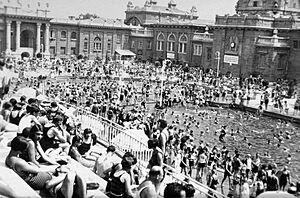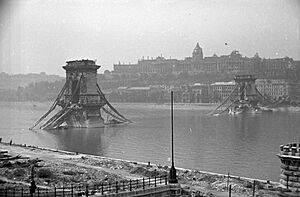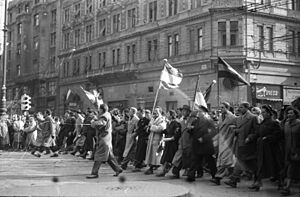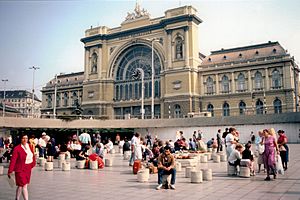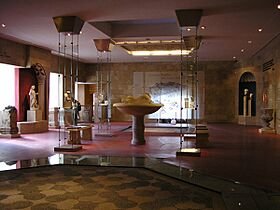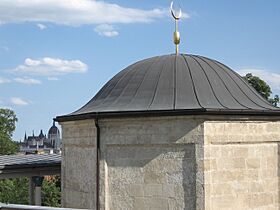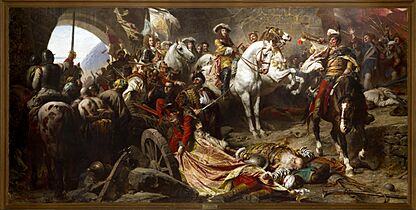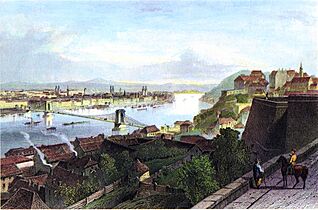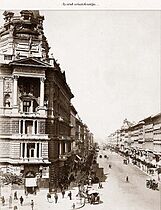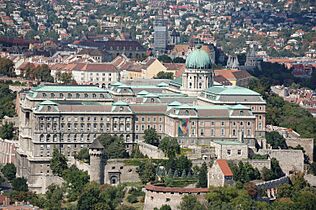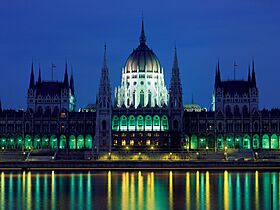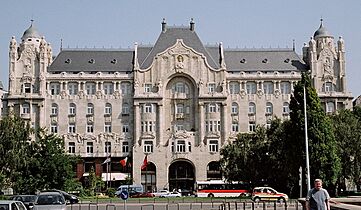History of Budapest facts for kids
| UNESCO World Heritage Site | |
|---|---|

Buda Castle from the Danube River
|
|
| Location | Budapest, Central Hungary, Hungary |
| Criteria | Cultural: (ii)(iv) |
| Inscription | 1987 (11th Session) |
| Extensions | 2002 |
| Area | 473.3 ha (1,170 acres) |
| Buffer zone | 493.8 ha (1,220 acres) |
The city of Budapest was officially formed on November 17, 1873. It was created by joining three nearby cities: Pest, Buda, and Óbuda. Later, in 1950, smaller towns around the original city also became part of Greater Budapest.
Budapest's story began with the Celts. They lived in the plains of Hungary around 400 BC. The powerful Roman Empire later took over this area. Around AD 100, the Romans built a fort and town called Aquincum where Budapest is today.
In the 5th century, the Huns drove out the Romans. Various tribes then fought for control over the next few centuries. The Hungarian conquest of the Carpathian Basin began in the late 800s. The Kingdom of Hungary was officially started by the late 1000s. From about 1300 until 1873, Buda served as the capital of Hungary several times.
Contents
Ancient Times: Celts and Romans
The first town here was built by the Celts in the 1st century BC. It covered about 30 hectares on the slopes of Gellért Hill. Archaeologists have found signs that it was a busy place. It likely had a special area for skilled workers like potters. It might also have been a trading center, as old coins from different places suggest.
The Romans took over this town around the start of the Christian era. Its people moved to the Danube plains. There, they built a new city, keeping the Celtic name Aquincum. In AD 106, Aquincum became the capital of the Roman province of Pannonia Inferior. The Roman governor and a large army were based here. About 20,000 people lived in the city. It was often involved in wars along the Roman Empire's border, which was the Danube River.
Middle Ages: New Rulers and Rebuilding
The Romans left the Hungarian plains in the 5th century AD. The Huns then took their place after some fierce battles. After the Huns' leader, Attila the Hun, died, their empire broke apart. Germanic tribes like the Lombards and the Avars then lived in the area. The Avar Khaganate controlled Pannonia from the 6th to the 9th centuries.
In 829, Pannonia became part of Bulgaria. This happened after the Avar Khaganate fell. Also, the Bulgarian army defeated the forces of the Holy Roman Empire. The Bulgarians built two border forts: Buda and Pest. These were on opposite sides of the Danube River.
While other tribes spread out, the clan of Árpád settled on Csepel Island. This is a large island in the Danube. They created a safe place for settlers. These settlers started farming in what is now southern Budapest. Under the Árpád dynasty, Hungary became a Christian country. Its capital was first Esztergom and then Székesfehérvár.
After some wars between Bulgaria and Hungary, Buda and Pest grew economically. This happened in the 12th century. Many French, Walloon, and German settlers moved there. They worked and traded along the Danube under the king's protection. Both towns were badly damaged during the Mongol invasion of Europe in 1241–42. German settlers rebuilt them. They renamed Buda "Ofen," meaning "furnace," because of its many lime kilns. The name Pest, which is Slavic, also means "furnace."
Renaissance: A Golden Age
In the 14th century, the Angevin kings of Hungary made Buda their royal home. They built many palaces on Várhegy (Castle Hill). The city reached its peak of power and beauty during the Renaissance. This was under "Good King" Matthias Corvinus. He ruled from 1458 to 1490. With his Italian wife, Queen Beatrice of Naples, he led a time of great wealth and art.
Hungary suffered a terrible defeat in the Battle of Mohács in 1526. The Turks, led by Suleiman the Magnificent, won this battle. This opened the way for the Ottoman occupation of Hungary. Suleiman's Siege of Buda (1541) was part of a smaller war. This war was between the Habsburgs and the Ottoman Empire.
In 1683, the Battle of Vienna took place. Three years later, a large European army attacked Buda Castle. This was the Battle of Buda (1686). They fought for six weeks and finally took it back. Both sides had many losses.
18th Century: A Quiet Time
During the 18th century, Budapest was a small, quiet town. It was not very important. This was under the rule of Charles VI, Maria Theresia, and her son Joseph II. Vienna, the capital of the Habsburg Empire, controlled many things. These included foreign affairs, defense, and taxes for the Kingdom of Hungary. A mostly formal assembly, called the Diet, met every three years in Pozsony (now Bratislava). This assembly ruled what was called "Royal Hungary".
19th Century: Growth and Revolution
In the early 1800s, Pest became the center of a reform movement. Count Széchenyi led this movement. He dreamed of progress for the city. His vision led to the building of the Lánchíd (Chain Bridge). This was the first permanent bridge between Buda and Pest. Before this, people used temporary pontoon bridges or boats.
The Hungarian Revolution of 1848 was part of wider revolutions in Europe. Lajos Kossuth and the "people's rights-liberals" led the parliament. Sándor Petőfi, a famous poet, and his friends planned to overthrow the Habsburgs. They met at the Café Pilvax in central Pest. From there, they gathered crowds in the streets. They marched to the Hungarian National Museum. Petőfi recited his powerful "National Poem" there. This stirred up strong feelings and started the revolution.
The civil war for independence ended in defeat for the Hungarians. The Habsburgs then showed their power. They built the Citadella on top of Gellért Hill. This fort was meant to scare the citizens. It had cannons and many soldiers watching over the city.
In 1867, the Austro-Hungarian Compromise of 1867 created the dual monarchy of Austria-Hungary. This was known as "k.u.k." The twin cities of Buda and Pest grew very quickly. They finally officially joined together. In 1870, a new board was created to plan the city's growth. It was led by Prime Minister Gyula Andrássy.
Budapest became a very important city. Its good location for transport was made even better. New roads and railways were built like spokes from a wheel. City planning began with the Metropolitan Council of Public Works. This council included important people like Gyula Andrássy. They designed the inner areas of Budapest. They created large ring roads and wide boulevards.
The fast building pace gave the city center a unified style. Different areas were set aside for business, homes, and factories. Pest was rebuilt like Paris. It got a main road called Nagykörút (Great Boulevard). Also, Andrássy Avenue was built. This avenue leads to Heroes' Square and a large park.
In 1896, Budapest celebrated 1,000 years since the Magyars settled the region. This brought a new wave of building. The first line of the Budapest Metro opened under Andrássy Avenue. Heroes' Square and Vajdahunyad Castle show the grand style of this time. New suburbs were built for the fast-growing population. Most people were now Magyar. But there were also many German and Jewish people who moved to the city. By the end of the 19th century, Budapest was a major cultural center in Europe.
20th Century: Wars and Changes
At the start of the 20th century, Budapest was full of culture and energy. It was like Vienna and Paris. This beautiful time ended with World War I. After the war, the Austro-Hungarian Empire collapsed. The Treaty of Trianon cut off half of Hungary's population. These people became part of neighboring countries.
In 1918–19, Budapest saw two revolutions. The Aster Revolution created the Hungarian Democratic Republic. Then came the Hungarian Soviet Republic, a short-lived Communist government. The Hungarian–Romanian War of 1919 ended with Romania occupying parts of Hungary. This included Budapest in August 1919. Then the Kingdom of Hungary was set up. It was led by Miklós Horthy.
Before World War II, about 200,000 Jewish people lived in Budapest. It was a center for Hungarian Jewish culture. In the late 1930s and early 1940s, Budapest was a safe place for Jewish refugees. Many came from Germany, Austria, and Slovakia. Hungary was allied with Nazi Germany. Between April and July 1944, Germans and Hungarians deported Jewish people from other parts of Hungary. By late July, Jewish people in Budapest were almost the only ones left in Hungary.
In June 1944, Hungarian officials ordered Jewish people into over 2,000 special buildings. These buildings were marked with Stars of David. About 25,000 Jewish people from Budapest's suburbs were sent to the Auschwitz-Birkenau camp. Hungarian officials stopped the deportations in July 1944. This saved the remaining Jewish people in Budapest for a while. Many looked for hiding places or protection. Foreign diplomats helped them. People like Raoul Wallenberg and Carl Lutz created false papers and safe houses. These actions saved tens of thousands of lives.
In October 1944, Germany took control and set up a new Hungarian government. This government was led by the fascist Arrow Cross Party. The remaining Jewish people in Budapest were again in great danger. The Arrow Cross started a time of terror. Hundreds of Jewish people were shot. They were also forced into hard labor. In November 1944, over 70,000 Jewish people were forced to march to camps in Austria. Thousands died from shootings, starvation, or cold.
In November 1944, the Arrow Cross ordered the remaining Jewish people into a closed ghetto. From December 1944 to January 1945, the Arrow Cross took people from the ghetto at night. They killed them along the banks of the Danube. Soviet forces captured Budapest on February 13, 1945. More than 100,000 Jewish people were still in the city then.
As the Germans retreated, they blew up all the Danube bridges. This was to slow down the Soviet Red Army. A two-month-long siege of Budapest destroyed much of the city. The Castle District was especially damaged. Most roofs were blown in by Soviet bombs. People hid in cellars and ate horsemeat to survive.
After 1945, free elections were held. Many parties were voted into Parliament. Due to Soviet pressure, the Communist Party gained power. By 1949, the Communist Party, with Soviet help, used a trick in the election system. They had their voters transported to many voting offices. There, they could vote multiple times.
The Communists took control, supported by the Soviet Army. Factories, bridges, and railways were built quickly. Workers often heard Soviet propaganda during their breaks.
In 1956, Imre Nagy became prime minister. He was popular for giving land to farmers. He wanted to create a system with many political parties. He declared Hungary's independence from the Soviet Union. He also said Hungary would leave the Warsaw Pact. University students and others organized peaceful protests in Budapest. They asked for Soviet troops to leave. They also wanted a free press and free elections.
The Soviet army moved into the city. Protesters built defenses. When tanks opened fire on the crowd in front of the Parliament, a national uprising began. Some Soviet soldiers even joined the Hungarian revolutionaries.
The Soviets were eventually pushed back. All surviving units were ordered to leave the city. Imre Nagy declared Hungary neutral. He said he would work with all countries and announced free elections. The Soviet Union feared NATO might place troops in Hungary. They saw this as a reason to invade. On November 4, the Warsaw Pact forces attacked. Imre Nagy fled to the Yugoslavian Embassy. He was later arrested by Soviet troops and secretly put on trial.
The Hungarian Revolution of 1956 was put down. János Kádár became the new leader. He made careful changes to create "Goulash Communism." This made Hungary different from other Soviet-bloc countries. By the late 1970s, Hungary was seen as the West's favorite Communist state. This was thanks to Kádár and large loans from Western countries.
A decade later, Budapest was a center for opposition. There were rallies and secret printing of forbidden materials. Talks between the opposition and government were held there. Finally, the government decided to open the borders. This was the first official break in the Iron Curtain. Hungary was declared a Republic on October 23, 1989. Free elections were then held. While communism fell in Berlin and Prague, in Hungary, the Socialist Workers' Party was simply voted out. This led to a peaceful change in the political system. Hungarians call everything that happened since then "after the System-change."
After 1989: A New Era
The revolutions of 1989 brought an end to Soviet control in Hungary. This meant the end of Communism in Hungary. Budapest used new economic chances to grow faster than other parts of the country. Many old Socialist factories closed. But new jobs appeared, especially in services and trade. In Budapest, unemployment is low, and average income is high.
New laws after the change gave Budapest's districts more rights. They could now own and pay for local public services. They could also decide how dense buildings would be in their areas. Local minority governments also started up. They mainly focused on cultural activities.
In October 2019, an opposition candidate, Gergely Karácsony, won the Budapest mayoral election. This was the first election setback for Hungary’s nationalist prime minister Viktor Orbán since he came to power in 2010.
Images for kids
-
Buda Castle Daytime




